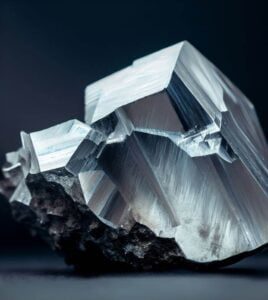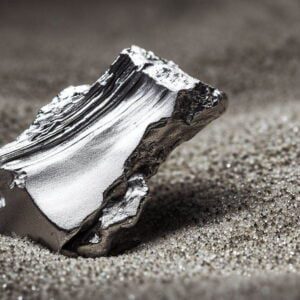Gold
Gold is a precious metal widely used in jewelry due to its beauty, rarity, and durability.
Gold in Jewelry
Gold is a masculine noun that refers to the chemical element with atomic number 79, with a bright yellow color, highly valued for its rarity and beauty. It also refers to objects or materials made of this metal, such as jewelry, coins, or ingots. By extension, the word "gold" is also used to refer to something very valuable, precious, or important, either literally or figuratively.
Gold is a highly valued precious metal appreciated for its beauty, durability, and rarity for centuries. Here are some important aspects of gold:
Gold physical properties
Gold is a soft, malleable, and ductile metal. It has a bright yellow color and a distinctive metallic luster. It is resistant to corrosion and does not tarnish, making it highly durable.
Gold in jewelry
Gold is widely used in jewelry manufacturing due to its beauty and malleability. Pure gold (24 karats) is too soft for use in jewelry, so it is mixed with other metals like copper or silver to increase its strength and durability. Gold alloys are expressed in karats, with 18K gold (75% pure gold) and 14K gold (58.3% pure gold) being the most common in jewelry.
Gold as investment
Gold is also considered a solid investment and a safe haven during times of economic uncertainty. Investors buy gold in the form of bars, coins, or ingots to diversify their portfolios and protect their wealth. The price of gold is influenced by various factors, such as global demand, supply, inflation, and economic movements.
Gold in industry
In addition to jewelry and investment, gold has applications in various industries. It is used in electronics, especially in the manufacturing of electronic devices, due to its conductivity and corrosion resistance. It is also employed in the dental industry, in the production of investment bars and coins, and in space technology.
Gold market and trade
Gold is traded in international commodity markets. Gold prices are quoted in US dollars per troy ounce (31.1 grams). Investors and traders can buy and sell gold contracts on stock exchanges or engage in physical gold transactions.
How to Choose Gold for Jewelry?
When choosing gold for jewelry, several factors should be taken into account, such as purity, color, price, and the style that suits you best.
List of characteristics:
Gold Karats
Gold is measured in karats (abbreviated as "kt" or "K"), which indicates the purity of the metal.
24-karat gold is pure gold in its most refined form (99.9% gold), but it is very soft and prone to scratches and damage.
For jewelry, however, gold is mixed with other metals to make it more durable, as pure gold is soft and malleable.
Common options are 18K gold (75% gold) with good strength and luster, 14K gold (58.3% gold) which is more affordable but less shiny, and 10K gold (41.7% gold).
Gold Color
Gold is not only available in the classic yellow color but can also be found in other colors. These colors are achieved by mixing gold with other metals.
The style that suits you best will depend on your skin tone, personality, and taste. You can choose between gold or silver based on your skin, identifying whether it is cool or warm. Cool-toned skin looks better with silver, white gold, or rose gold, while warm-toned skin complements yellow gold or green gold. You can also combine different gold colors or add precious or semi-precious stones that harmonize with your skin and clothing.
Some popular options are:
Yellow Gold
Yellow gold is the most classic color and the one most commonly used in jewelry making. To manufacture yellow gold for jewelry, pure gold is mixed with alloy metals such as zinc and copper.
Yellow Gold
Yellow gold is a classic and traditional color associated with the sun, energy, and exclusivity. Yellow gold can be a good choice if you like jewelry with a vintage, elegant, or sophisticated touch. Yellow gold also pairs well with gemstones of different colors, especially rubies, sapphires, and emeralds.
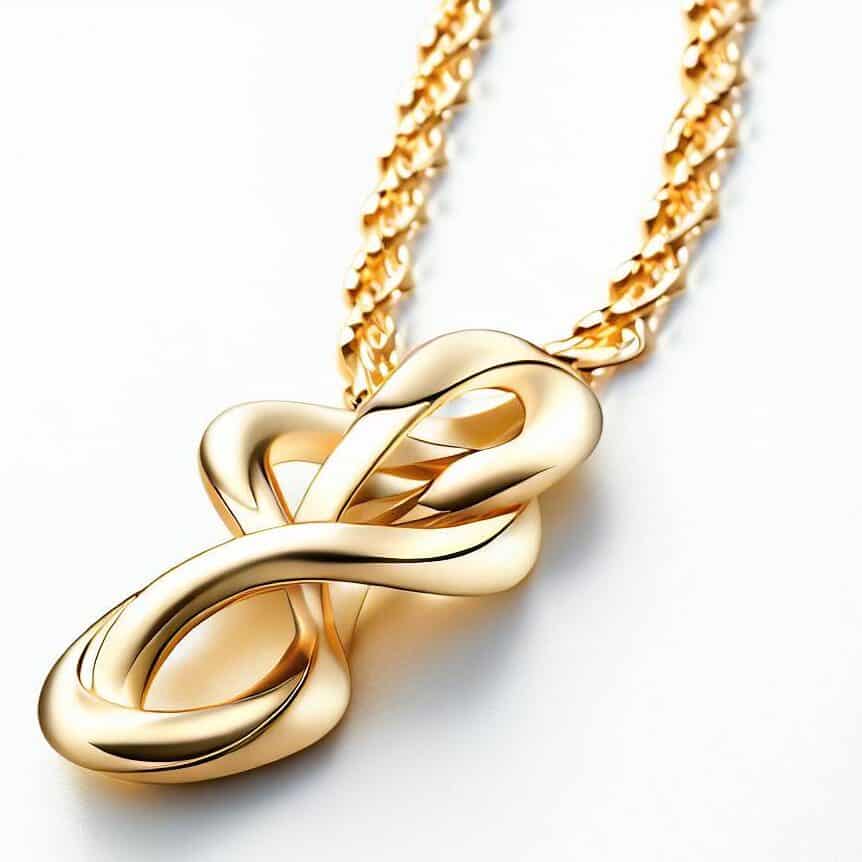
Necklace with Pendant
Skin Tone: Yellow gold is a warm color that complements all skin tones, especially darker or tanned skin. Yellow gold can add brightness and contrast to the skin, while white gold may appear cooler or less vibrant.
To make and manufacture yellow gold jewelry, different techniques and methods are followed, such as casting, rolling, cutting, soldering, polishing, setting, and finishing.
White Gold
White gold is more modern and is achieved by adding palladium or nickel to pure gold.
White gold is a modern and chic color that enhances colorless gemstones with a very elegant tone-on-tone effect. White gold can be a good choice if you like jewelry with a minimalist, contemporary, or sophisticated touch. White gold also pairs well with gemstones of different colors, especially sapphires, rubies, and emeralds.
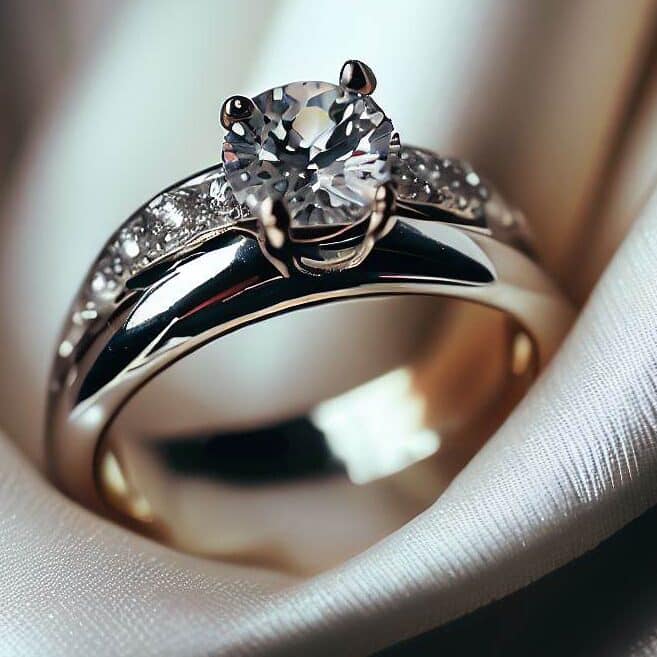
White Gold Diamond Wedding Bands
Skin Tone: White gold is a cool color that complements lighter or rosy skin tones. White gold can add elegance and modernity to the skin, while yellow gold may appear warmer or more traditional.
To make 18-karat white gold, 75% pure gold, 16% palladium, and 9% silver are needed. This results in a slightly yellowish-toned piece of white gold.
A rhodium plating is applied to the piece of white gold through an electrolysis process. Rhodium is a very white and bright metal that enhances the appearance of white gold and protects it from oxidation and wear. The rhodium plating has an additional cost and needs to be renewed periodically.
Rose Gold
Rose gold is produced by mixing pure gold with copper. Pure gold is very soft and easily deformable, so it is mixed with copper to give it more hardness. Copper also gives gold its characteristic pink color.
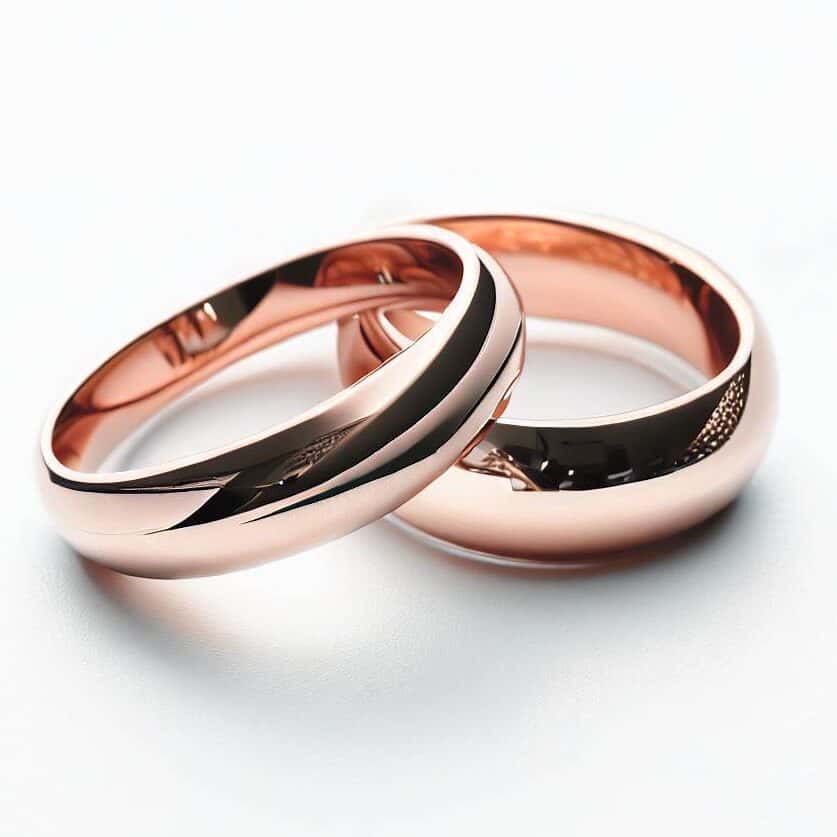
Rose Gold Wedding Rings
Rose gold is considered the most romantic metal and complements all skin tones. It is favored for its blend of pink and golden tones, being distinctive in color and warmer than white or platinum gold.
Rose gold originated in Russia in the 19th century and was called "Russian gold." It then gained popularity in the Victorian era and in the 1940s when platinum became scarce due to World War II. Currently, rose gold is a popular choice for wedding and engagement rings, as well as for other pieces of jewelry.
To make 18-karat rose gold, 75% gold, between 21% and 25% copper, and the rest is completed with silver. Silver is added to increase the durability of the metal.
Green Gold
Green gold is obtained by incorporating more silver than copper into pure gold. It is less common than yellow, white, or rose gold and has a more natural and fresh appearance.
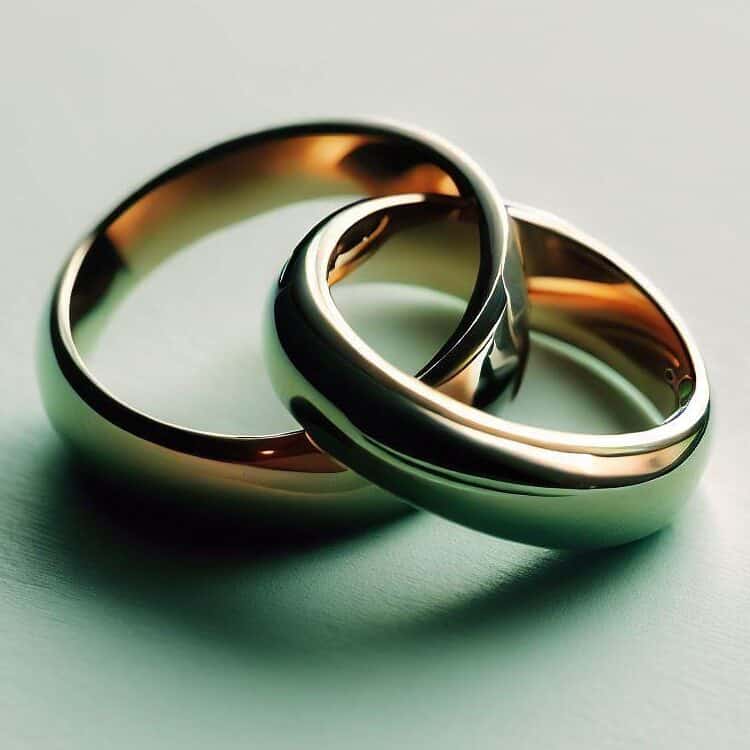
Green Gold Wedding Rings
Green gold is considered an ecological and sustainable metal, as silver is a recyclable and abundant metal.
Green gold originated in France in the 19th century and was called "Paris gold." It then gained popularity in the Art Nouveau era and in the 1920s, when it was combined with brightly colored gemstones. Currently, green gold is an original and sophisticated choice for wedding and engagement rings, as well as for other pieces of jewelry.
Quality Marks and Authenticity Certificates
In many countries, gold jewelry must bear a quality mark indicating the purity of the gold. These marks can be stamps or hallmarks and are usually located in a discreet place on the piece, such as the inside of a ring. Make sure to familiarize yourself with the specific quality marks of your region.
A warranty certificate for gold jewelry is a document issued by the manufacturer or authorized seller that supports the authenticity of the gold jewelry and provides relevant information about its quality and characteristics. Below are some typical information elements that should be included in a warranty certificate for gold jewelry:
Manufacturer or Seller Identification: It should include the name and contact information of the manufacturer or seller responsible for the jewelry.
- Jewelry Description: It should provide a detailed description of the gold jewelry, including the design, type of jewelry (ring, necklace, bracelet, etc.), and any special features.
- Karat Information: It is crucial to indicate the number of karats or the purity of the gold used in the jewelry. For example, if it is 18-karat gold, it should be indicated as "18K" or "750" (representing 75% pure gold and 25% other metals).
- Gold Weight: The weight of the gold used in the jewelry should be indicated, usually expressed in grams.
- Quality Mark or Hallmark: It should include the mark or hallmark that certifies the authenticity and quality of the gold used in the jewelry. This may vary depending on the country or region.
- Gem Details (if applicable): If the gold jewelry contains gemstones, details about the type of gemstones, their quality, carat weight, color, clarity, and any special treatments applied to the gemstones should be provided.
- Warranty and Policies: It should detail the warranty conditions, including the duration and what it covers. Additionally, the return, repair, or replacement policies in case of defects or issues with the gold jewelry may be mentioned.
Remember that the exact information may vary depending on the manufacturer or seller, so it is important to review the specific warranty certificate provided with the gold jewelry.
Manufacturing of Gold for Jewelry
In the manufacturing of gold jewelry, different alloys are used to enhance the properties of pure gold. These alloys may include copper, silver, zinc, and nickel, among other metals. The choice of the alloy depends on the desired tone and durability.
- The amount of pure gold (24 karats) needed to achieve the desired purity (18, 14, or 10 karats) is weighed and placed in a crucible.
- The other metals are added in appropriate proportions according to the desired color and hardness.
- The crucible is heated to over 1000 degrees Celsius until the metals melt and mix homogeneously. It is a delicate and precise process that requires the skills of a professional jeweler.
- The molten alloy is poured into a mold with the desired shape and allowed to cool until it solidifies.
Gold care and cleaning
See section: How to Clean Gold Jewelry?
Industrial and technological use
In addition to its aesthetic and monetary value, gold has numerous industrial and technological applications. It is used in electronics, medicine, jewelry manufacturing, and the aerospace industry, among other fields. Its electrical conductivity and resistance to corrosion make it extremely useful in various applications.
Gold from antiquity to the present
The history of gold in jewelry dates back to ancient times and has been cherished for its beauty and value. Here is an overview of the history of gold in jewelry:
Gold jewelry in antiquity
Gold has been used in jewelry since ancient civilizations. The ancient Egyptians were famous for their skill in working gold and created exquisite jewelry with this metal. Gold jewelry was a symbol of status and power and was worn by both men and women.
Gold jewelry in Ancient Greece and Rome
In ancient Greece, gold jewelry was adorned with precious gemstones and enamels. The Romans also appreciated gold in their jewelry, using techniques like filigree and gemstone setting.
Gold jewelry in the Medieval and Renaissance periods
During the Middle Ages, the church played an important role in gold jewelry, creating religious pieces and ornate relics. During the Renaissance, gold jewelry experienced a revival, with artists and goldsmiths creating elaborate and detailed designs.
Gold jewelry in the Baroque and Rococo periods
In the 17th and 18th centuries, gold jewelry became more ostentatious and extravagant. Techniques like repoussé, gem setting, and combining gold with enamels and pearls were used.
Gold jewelry in the 19th Century and early 20th Century
During the Victorian era, gold jewelry was influenced by fashion and romantic styles. Gems such as diamonds, sapphires, and rubies were used, and jewelry pieces with floral and lattice motifs were created. In the early 20th century, Art Nouveau introduced organic and curvilinear designs into gold jewelry.
Contemporary gold Jewelry
Today, gold jewelry encompasses a wide range of styles and designs. Different gold karats, such as 18K, 14K, and 10K gold, are used to create durable and affordable jewelry. In addition to traditional techniques, modern jewelry manufacturing methods such as 3D printing and laser engraving are used.
Gold continues to be one of the most popular metals in jewelry due to its timeless beauty and ability to withstand the test of time. Whether in the form of rings, necklaces, bracelets, or earrings, gold jewelry continues to be a form of personal expression and a symbol of luxury and elegance.
Value and Investment
See section: How to Invest in Gold Jewelry?
History of Gold
See section: Gold from Antiquity to the Present.
Gold as Currency
See section: The Use of Gold as Currency.
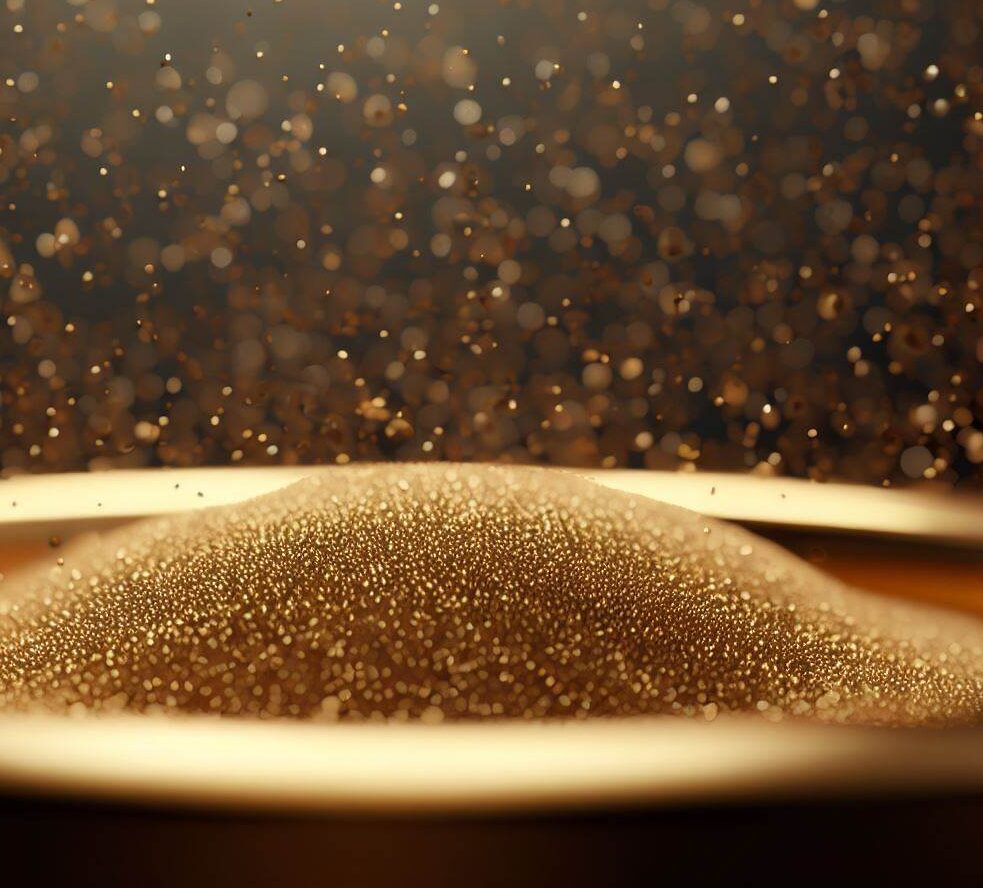

Sandra Sanchez
Sandra is passionate about jewelry and interior design. She graduated in interior design from Universidad Taller 5 in Colombia and has completed several courses and postgraduate studies in Jewelry in Barcelona and Madrid, Spain. She combines her work as a jeweler and interior designer with teaching.
